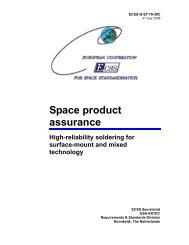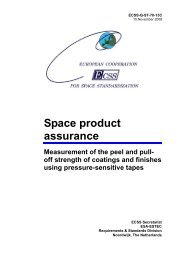ECSS--Q--70--07A
ECSS--Q--70--07A
ECSS--Q--70--07A
Create successful ePaper yourself
Turn your PDF publications into a flip-book with our unique Google optimized e-Paper software.
<strong>ECSS</strong>--Q--<strong>70</strong>--<strong>07A</strong><br />
<strong>ECSS</strong> 20 January 1998<br />
4.1 Design<br />
4.2 Rework<br />
4<br />
General<br />
Designers of printed-circuit boards shall be familiar with design parameters that<br />
are necessary for the wave-soldering process. Circuit tracks that are spaced close<br />
together should be oriented in line with the pass direction to avoid solder bridging.<br />
Large heat sink areas should be avoided; these will include ground planes<br />
and large leads closely connected to massive metal parts.<br />
Space-quality requirements of solder joints (<strong>ECSS</strong>--Q--<strong>70</strong>--08) shall be met without<br />
more than 5 % rework on each wave soldered circuit.<br />
NOTE Deficient wave-soldered connections are caused most frequently<br />
by the movement of component leads during solidification, the<br />
presence of solder alloy within stress relief bends and the entrapment<br />
of machine oils and solder fluxes within the solder fillet.<br />
Rework of any nature is costly. It involves not only the risk of irreparable<br />
lifted pads and measling, but also the possibility of<br />
heat damage to sensitive components.<br />
A solder-joint-discrepancy log, such as that given in annex B, shall be maintained<br />
as an aid to process control, optimisation of parameters and repeatability.<br />
15
















